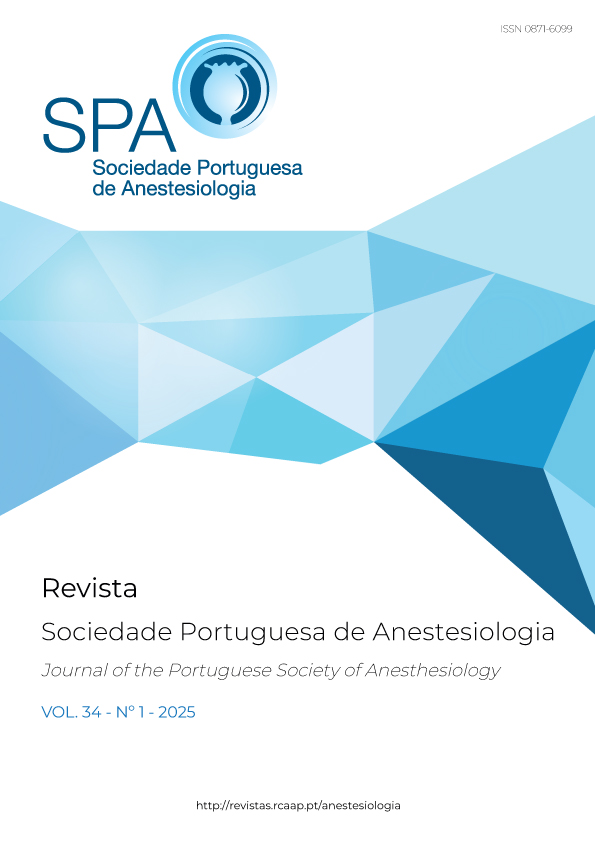Experiência Anestésica Inicial em Cirurgia Cardíaca Robótica: Série de Casos de um Centro de Cuidados Terciários na Índia
DOI:
https://doi.org/10.25751/rspa.39817Palavras-chave:
Anestesia, Procedimentos Cirúrgicos Cardíacos, Procedimentos Cirúrgicos Minimamente Invasivos, Procedimentos Cirúrgicos Robóticos, Ventilação MonopulmonarResumo
Um dos desenvolvimentos mais recentes na prática cirúrgica é a cirurgia robótica minimamente invasiva. A utilização de um robô cirúrgico facilita uma cirurgia menos invasiva. Esta abordagem à cirurgia cardíaca oferece inúmeras vantagens potenciais ao doente, incluindo a redução da dor, um menor tempo de internamento hospitalar e um regresso mais rápido às atividades diárias. A cirurgia robótica exige que o pessoal de anestesia incorpore várias competências de subespecialidade para melhorar o resultado do paciente. Na era da cirurgia minimamente invasiva e da crescente popularidade das cirurgias cardíacas robóticas, é imperativo que o anestesiologista cardíaco esteja bem familiarizado com os vários sistemas robóticos e complicações associadas, experiência em ecocardiografia transesofágica (ETE) e domínio e gestão de técnicas de isolamento pulmonar. A coordenação e o planeamento próximos com a equipa cirúrgica e de perfusão são essenciais para garantir um atendimento seguro ao doente.
Downloads
Referências
Carpentier A, Loulmet D, Aupècle B, Kieffer JP, Tournay D, Guibourt P, et al. Chirurgie à coeur ouvert assistée par ordinateur. Premier cas opéré avec succès. C R Acad Sci III. 1998;321:437-42. doi: 10.1016/s0764-4469(98)80309-0.42.
DeRose JJ, Ashton RC, Belsley S, Swistel DG, Vloka M, Ehlert F, et al. Robotically assisted left ventricular epicardial lead implantation for biventricular pacing. J Am Coll Cardiol. 2003;41:1414-9.
Mohamed A, Shehada SE, Brakel LV, Ruhparwar A, Hochreiter M, Berger MM, et al. Anesthetic management during robotic-assisted minimal invasive thymectomy using Da Vinci system. A single center experience. J Clin Med. 2022;11:4274. doi: 10.3390/jcm11154274.
Bonaros N, Schachner T, Wiedemann D, Oehlinger A, Ruetzler E, Feuchtner G, et al. Quality of life improvements after robotically assisted coronary artery bypass grafting. Cardiology. 2009;114:59-66. doi: 10.1159/000212115.
Rehfeldt KH, Mauermann WJ, Burkhart HM, Suri RM. Robot-assisted mitral valve repair. J Cardiothorac Vasc Anesth. 2011;25:721-30. doi: 10.1053/j.jvca.2011.03.186.
Hafiani H, Choubhi M, Ameur A, Bensghir M, Abouelalaa K. Anesthetic considerations in robotic surgery: a comprehensive review. J Robot Surg. 2024;18:220. doi: 10.1007/s11701-024-01974-y.
Klingstedt C, Baehrendtz S, Bindslev L, Hedenstierna G. Lung and chest wall mechanics during differential ventilation and with selective PEEP. Acta Anaesthesiol Scand. 1985;29:716-21.
Chauhan S, Sukesan S. Anesthesia for robotic cardiac surgery. An amalgam of technology and skill. Ann Card Anaesth. 2010;13:169-175.
Liu TJ, Shih MS, Lee WL, Wang KY, Liu CN, Hung CJ, et al. Hypoxemia during one- lung ventilation for robot-assisted coronary artery bypass graft surgery. Ann Thorac Surg. 2013;96:127-32. doi: 10.1016/j.athoracsur.2013.04.017.
Deshpande SP, Lehr E, Odonkor P, Bonatti JO, Kalangie M, Zimrin DA, et al. Anesthetic management of robotically assisted totally endoscopic coronary artery bypass surgery (TECAB). J Cardiothorac Vasc Anesth 2013;27:586-99. doi: 10.1053/j.jvca.2013.01.005.
Baraka A. Differential lung ventilation as an alternative to one-lung ventilation during thoracotomy. Report of three cases. Anaesthesia. 1994;49:881-2.
Kiaii B, Bainbridge D, Fernandes P. Surgical, anesthetic, perfusion-related advances in minimal access surgery. Semin Cardiothorac Vasc Anesth 2007;11:282-7.
Hong JY, Kim JY, Choi YD, Rha KH, Yoon SJ, Kil HK. Incidence of venous gas embolism during Robotic-Assisted Laparoscopic radical prostatectomy is lower than that during radical retropubic prostatectomy. Br J Anaesth. 2010;105:777-781.
Downloads
Publicado
Como Citar
Edição
Secção
Licença
Direitos de Autor (c) 2025 PRIYANKA GUPTA, SHAILLY KUMAR, UDISMITA BARUAH, Ira Balakrishnan M

Este trabalho encontra-se publicado com a Creative Commons Atribuição-NãoComercial 4.0.
Os artigos estão livremente disponíveis para serem lidos, descarregados e partilhados a partir do momento da sua publicação.
A RSPA reserva-se o direito de comercialização do artigo enquanto parte integrante da revista (na elaboração de separatas, por exemplo). O autor deverá acompanhar a carta de submissão com a declaração de cedência de direitos de autor para fins comerciais.
Relativamente à utilização por terceiros a Revista da SPA rege-se pelos termos da licença Creative Commons “Atribuição – uso Não-Comercial (CC BY-NC).
Após publicação na RSPA, os autores ficam autorizados a disponibilizar os seus artigos em repositórios das suas instituições de origem, desde que mencionem sempre onde foram publicados.


